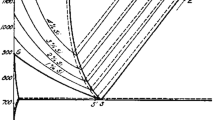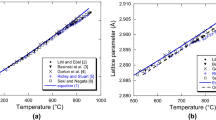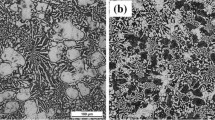Abstract
In cast iron, silicon and aluminum are elements that promote graphite precipitation and strengthen the alloy by solid solution. In the present work, Si has been substituted by Al leading to values that easily surpass standard properties of Fe–C–Si gray cast irons, reaching a strength of 466 MPa at moderate hardness (250 HB) for an iron with 3.08% C, 3.15% Al and 0.16% Si. Sequences of heats increasing Al content were carried out. It was found that the UTS increases with the Al content, reaching a maximum at about 3% Al, after which it decreases. Graphite area measurements show a minimum at the maximum UTS, with graphite exhibiting random orientation. Carbides are avoided above 1.5% Al for very low Si content (about 0.2%) in Y2 keel blocks (25 mm thickness). Plates as thin as 2.5 mm were cast free of carbides from irons with more than 3% Al, which makes this material very desirable for thin wall castings. Additions of other elements were necessary, including 0.35% chromium, 0.55% manganese and 0.075% tin to obtain a pearlitic structure.














Similar content being viewed by others
References
E. Hugony, Le ghise all’aluminio. Caracteristichi, technologia e aplicazione, La Fonderia Italiana 2, 33–46 (1965)
E. Piwowarsky, E. Sohnchen, The effect of aluminum on cast iron. Metallwirtschaft 12, 417–421 (1933)
E.U. Petitbon, J.F. Wallace, Aluminum alloyed gray iron—properties at room and elevated temperatures. AFS Cast Met. Res. J. 9, 127 (1973)
F. Henke, Heat resistant cast iron. Giess. Prax. 5(72–81), 87–93 (1969)
R.P. Walson, Aluminum alloyed cast irons properties used in design. AFS Trans. 85, 51–58 (1977)
C. Defrancq, J. Van Eeghem, A. DeSy, Study of the inoculation of gray cast irons from the Fe–C–Al system; development of a new flake graphite cast iron with very high strength, in 36th International Foundry Congress, Belgrade, CIATF (1969)
C. Defrancq, J. Van Eeghem, A. DeSy, Further development of aluminum cast iron inoculated with high amounts of calcium, in 40th International Foundry Congress, Moscow, CIATF (1973)
J.A. Yaker, L.E. Byrnes, E.H. Petitbon, W.C. Leslie, Microstructures and strength of aluminum-containing gray and nodular irons in the temperature range 1200–1800 °F (649–982C). AFS Trans. 84, 305–320 (1976)
D.M. Stefanescu, F. Martinez, Compacted/vermicular graphite cast irons in the Fe–C–Al system. AFS Trans. 90, 39–46 (1982)
F. Martinez, D.M. Stefanescu, Properties of compacted/vermicular graphite cast irons in the Fe–C–Al system produced by ladle and in-mold treatment. AFS Trans. 91, 593–606 (1983)
D.M. Stefanescu, F. Martinez, Compacted graphite cast irons in the iron–carbon–aluminum system, U.S. Patent no. 4,501,612 (1985)
H.M. Muhmond, H. Fredriksson, Graphite growth control analysis in high Al cast iron. Int. J. Cast Met. Res. 29(5), 272–278 (2016)
F. Mampaey, aluminum cast irons: solidification, feeding and oxygen activities, in AFS Transaction vol. 69, Paper 05-149 (2005)
A. Shayesteh-Zeraati, H. Naser-Zoshki, A.R. Kiani-Rashid, Microstructural and mechanical properties (hardness) investigations of Al-alloyed ductile cast iron. J. Alloys Compd. 500, 129–133 (2010)
A. Shayesteh-Zeraati, H’ Naser-Zoshki, A.R. Kiani-Rashid, M.R. Yousef-Sani, The effect of aluminium content on morphology, size, volume fraction, and number of graphite nodules in ductile cast iron, in Proceedings of IMechE, Part L: Journal of Materials: Design and Applications, vol. 224, pp. 117–122 (2010)
F. Neumann, The influence of additional elements on the physico-chemical behavior of carbon in carbon saturated molten iron, in Recent Research on Cast Iron, ed. by H.D. Merchant (Gordon and Breach, NY, 1968), pp. 659–705
D.M. Stefanescu, J. Lacaze, Thermodynamics principles as applied to cast iron, in ASM Handbook, Cast Iron Science and Technology, ed. by D.M. Stefanescu (ASM Int., Materials Park, Ohio, 2017), pp. 31–45
E. Aguado, M. Ferrer, P. Larrañaga, D.M. Stefanescu, R. Suárez, The effect of the substitution of silicon by aluminum on the mechanical properties of gray iron, in 73rd World Foundry Congress, Krakow, Poland (2018)
Acknowledgements
The authors would like to acknowledge Diputación Foral de Bizkaia for supporting this research.
Author information
Authors and Affiliations
Corresponding author
Additional information
This paper is an invited submission to IJMC selected from presentations at the 73rd World Foundry Congress, held September 23–27, 2018, in Krakow, Poland, and has been expanded from the original presentation.
Rights and permissions
About this article
Cite this article
Aguado, E., Ferrer, M., Larrañaga, P. et al. The Effect of the Substitution of Silicon by Aluminum on the Properties of Lamellar Graphite Iron. Inter Metalcast 13, 536–545 (2019). https://doi.org/10.1007/s40962-018-00303-y
Published:
Issue Date:
DOI: https://doi.org/10.1007/s40962-018-00303-y




